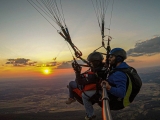Many of these sports require coordination and teamwork, as although they are not primarily team sports, it is recommended to practise them with at least one other person.
The settings where these sports have taken place over the years are tied to the natural world—whether the sea, mountains, rivers, or even the sky, as many are aerial sports like skydiving or paragliding, among others. In recent times, urban variations of these sports have also emerged, such as skateboarding.
The history of these sports spans decades, in some cases centuries, but what’s most fascinating is that each sport has its own unique story, as they are incredibly diverse. From ancient practices like snowshoeing to modern innovations like flyboarding, adventure sports have evolved dramatically.
What they do share in common is that most originated out of necessity before becoming hobbies—or, in many cases, a lifestyle we all recognise today.
History of Skydiving
Since ancient times, mankind’s dream has always been to fly, and great civilisations as well as brilliant minds have strived to achieve it. Some credit the Chinese as the pioneers of skydiving, while others point to Oliver of Malmesbury, an 11th-century English monk. Others still attribute the invention of the parachute to Leonardo Da Vinci and his "baldacchino" design.

Whoever it was, the idea of parachuting dates back centuries. Over time, successful attempts have shaped the history of this extreme sport, which has logically evolved into what we know today. If you’re keen to experience this sport’s history and modern practice firsthand, click here. Don’t hesitate—it’s one of the greatest thrills out there.
History of Rock Climbing
Climbing was once a means for humans to secure food and shelter, but rock climbing as a sport originated in the 18th century, specifically in the Alps. In 1786, Dr. Gabriel Paccard summited Mont Blanc with the help of his guide, Jacques Balmat.

From that moment, interest in mountaineering soared, and ascents of high peaks became increasingly common. Over the years, different styles emerged, from sport climbing to big-wall climbing and eventually the artificial climbing techniques we know today—all of which are still practised.
History of Rafting
Rafting as we know it today emerged around the 1950s, though its roots trace back centuries to log transportation on rivers. There are also records of an American lieutenant navigating the Platte River in 1842, which could be considered an early form of the sport.

After rafting was included as a competitive event in the 1972 Munich Olympics, it gained global popularity. In Spain, the sport took off in the 1980s.
Spring is the peak season for rafting due to mountain snowmelt, which swells river currents. If you’re after an adrenaline rush, it’s just a click away.
History of Paragliding
Paragliding was initially used by climbers and mountaineers to descend from peaks they had summited. Like skydiving, its origins are linked to Leonardo Da Vinci, as well as the Wright Brothers and Francis Rogallo, among others. Another pioneer was Otto Lilienthal, who conducted over 2,000 test flights, some exceeding 300 metres in distance.

Since the 1970s, paragliding has grown in popularity worldwide, with safety measures now standardised. Today, it’s one of the most popular aerial sports for enthusiasts globally.
History of Skiing
Skiing originated over 6,000 years ago in Russia, where the oldest known skis were discovered. Humans used them to traverse snow during harsh winters.

It gained popularity in the 20th century thanks to Sondre Nordheim, who pioneered a new sporting discipline. Skiing spread rapidly worldwide, with improvements in bindings and edges. In Spain, locations like Puerto de Navacerrada and Candanchú became early skiing hubs, later evolving into full ski resorts. Today, it’s the most practised winter sport in the world.
Nowadays, adventure sports have gained widespread appeal, transitioning from a niche activity in the 1980s to a mainstream pastime for weekends, stag parties, romantic getaways, or corporate team-building events.
You don’t need to be an expert athlete to try them at an amateur level, as all these sports offer options for beginners with specialised instructors and varying difficulty levels, making them accessible to everyone from children to seniors.

The surge in popularity of these sports over recent decades comes down to the incredible sensations they provide—adrenaline rushes far removed from daily life, a connection with nature we rarely experience, and the chance to share unforgettable moments with friends and loved ones.











